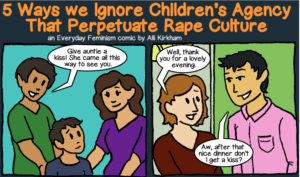Originally published on Wear Your Voice Magazine and republished here with their permission.
Recently, in an online exchange of “friendly fire” regarding the validity of campus assault statistics, I was ruffled by the sharing of an article questioning the 1:4 women experience campus assault statistic.
Of course, the complex nature of assault statistics is not new, and I jumped to my anti-victim shaming stance. My friend, not denying assaults happen, took issue with a statistic which she saw as perpetuating the view of women needing protection.
Her exact words: “I am worried that these fears return to treating women as delicate flowers.” She went on to say, “I want to raise a daughter who knows the difference, how to be tough enough to take care of herself where she can, and when to get help.”
While I was bothered by her criticism of the statistic, she was concerned with the imagery it portrayed. I was not quick to meet her where she was – with three college students to call my own, I know firsthand campus assaults are a significant issue.
I ended on a mutually agreeable note – that faulty statistics serve no movement well and are fuel for the non-believers.
Ultimately, valid data may indeed be needed to affect systemic change, for universities to care more for people than for perception. In the meantime, we know assault exists. We need to raise our young people to understand consent, taking care of themselves when they can, and when to get help when they need it.
Right from the start, so much of how we parent can teach our children about consent.
Are we abrupt with our toddlers when we switch to the next task or do we provide signals that a transition is going to happen? Do you offer choices, or do you just direct your child around? Do you allow your children to talk back or do you insist on uninterrupted compliance?
Do negotiations take place in your home or is it “my way or the highway”? Do your children understand self-agency and power differential, are you teaching them to trust their instincts?
Allowing our children to speak for themselves is the first step in teaching consent. Children need both voice and feel empathy to understand consent, because of course, consent is not a one-way street.
Our children must learn how to give as well as how to receive consent.
Below are a few tips for this part of your parenting journey.
1. Transitions
Providing transitional signals between tasks starts at birth. Sensitive caregivers regularly talk to their infants and narrate diaper changes as if a baby has full capacity to understand language.
Although the capacity for interactive language may yet to be fully developed, the gentle timing and pause of a caregiver’s voice create a pattern of treatment infants are fast to integrate into their experience of the world.
To the crying baby, “I know you don’t like diaper changes but Mommy needs to keep your bottom clean, okay almost done, the wipe is going to be cold,” to the bedtime meltdown, “I know going to bed isn’t fun, it is hard to leave the fun of daytime; our bodies need sleep to be healthy so let’s read a book to help with settling our body down.”
How does this relate to consent you might ask? Consent is most often based on feeling safe in an interaction; providing the benchmark experiences for safe, respectful interactions is perhaps the most significant gift we can give children.
2. Feelings, Feelings, Feelings
My feelings, your feelings, and all feelings count. Feelings should not only be felt, but they should also be named and talked about.
Some feelings are simple, some feelings are more complex, some are pleasant, and some are not-but all feelings need to be identified, discussed and processed.
Respect for your elders is all well and good, but there is a happy balance to reach to raise children who not only recognize their voice as means to empowerment, but who will also understand the point at which their voice has been unjustly silenced. Support your child’s development of inner voice by recognizing and discussing feelings.
3. Anything, Anytime, Anywhere
The ultimate open door policy – you can tell me anything. And by anything, I really mean anything and without judgment.
The ultimate challenge of parenthood is to avoid being judgmental. Sex, drugs, rock, and roll. My motto is that you’d rather know than not know if it means the difference in being there for your kid. Only you can keep that door open no matter what.
4. Independent Skill Set
The sooner children learn to take on their own body care, the sooner they develop an understanding of self. Our job as caregivers is to allow children to take ownership of their own body as soon as it is developmentally possible.
This is perhaps the first step in self-agency-sending the message, “This is your body, your job to care for it.”
I often wonder if the phenomenon of helicopter parenting has lessened an understanding of self-agency and ownership of body. Know when to put the hovercraft in the hangar as development allows. This person you are supporting is a process, not a product.
You are supporting a trajectory, not creating a masterpiece.
5. Kicking and Screaming
Sure, verbal means are the best way to resolve conflict, but are there times fighting back makes sense?
How about in the pool when your child is held under whether on purpose or by accident? I have friends who set the rule for the kids whenever ever they swim together, if you feel in danger because of another child, you are allowed to kick and scream and fight your way to air no matter what.
I have never countered this rule with my own children. There are times kicking and screaming to protect your welfare are warranted. It is okay to teach the balance.
6. Gathering Opinions
It has long been general parenting knowledge that a balance between permissive and authoritarian parenting is better all around. The middle of this continuum is called authoritative parenting.
While keeping our children’s needs, wants and opinions in mind as a parents we ultimately make many decisions on their behalf, as we should. But the mere demonstration of taking their opinions into account gives them their initial experiences of giving voice.
7. No Means No
Follow through when you set limits. If you set limits and back away, your child learns that sometimes no means yes.
No means no. I, personally, have established very few make or break rules, but the ones I do set are steadfast and so is the logical consequence which follows. If it is a clearly set limit about behavior follow through on the logical consequences.
Don’t start on the slippery slope of allowing excuses to be explained away.
8. Just say ‘No’ to Saying Sorry
Saying sorry is an abstract concept. Caregivers who insist on sorry-saying are mistakenly creating a rote solution to conflict resolution.
Instead, I suggest having children look each other in the eyes, ask how they can make something better, discuss alternatives to whatever has transpired.
How do you think you made ___(me, your friend, your sibling)___ feel? What might we do next time?
I just don’t know about the whole idea of saying sorry. I am one of those people who says sorry for shit that isn’t remotely my fault – it rains – and I apologize for fuck’s sake. But even as we grow, demonstrating our regret and our empathy by making good on changes in behavior is the true measure.
9. Power Differential
Oh boy, here we go. Without taking anyone’s self-agency away, I suggest that there are just plain and simple times when no consent exists.
There is limited consent when heavy drug and alcohol are in the mix. There is limited consent between boss and employee. Teach it! Understanding power differential is an often forgotten piece of the pie and is a core tenant of intersectional feminism.
10. Norms
As parents, we often err on the side of sheltering our children from the realities of the world. Instead, I suggest we openly talk about boundaries and rules along with explaining why boundaries exist:
“Adults never ask you to keep a secret about anything from your parents.”
“Adults you don’t know don’t ask kids for help doing something. They ask other adults.”
I’m sure you get the gist of what I’m saying and could add a slew more to the list.
In the past year, I also told my adolescent daughter that it is not normal for an adult to make sexual innuendos to a teen. Without creating fear, we need to find appropriate times to provide general knowledge about adults and norms.
11. Boundaries and Rules
Some shit you just don’t do, even if it feels good, even if our emotions tell us it is okay.
It seems counter-intuitive to some folks, but the fact is, limits and rules about behavior make children feel safer. Running amuck all of the time makes children and their lives feel out of control. The goal as children grow older is that they’ll learn the limits and boundaries which are right for them.
Here’s the thing I know about child development and self-agency: choose three children of the same chronological age, and those three kids are going to have three different constitutions, three different developmental trajectories.
No matter how one child perceives their self-agency at the hands of an abuser, the next child is different. This holds true into young adulthood as well. This is why statutes, rules, and boundaries matter.
12. Monitor Adult and Screen Behavior
Be thoughtful of what your children take in. You, at least until the teen years when peers take over the lead, are the greatest role model. Chances are what a child deems acceptable during childhood and adolescence is based on what they see you DO, not just what they hear you say.
Same goes with watching mature content together. We all make our own decisions about content with our children; I venture not into those muddy waters with you.
What really matters is how we discuss mature content with our children. Start with a running commentary of or why not a relationship on screen is appropriate.
***
Ultimately, I know as a parent I cannot protect my children entirely through my parenting choices.
I am not to blame for the world outside my doors. Victims are not to blame when silenced or ignored.
But parents can provide children a voice.
We can also provide our children a clearinghouse for their stories. We can also support the development of empathy to understand how to give voice to others. Consent is a two-way street; both in the giving and the receiving.
[do_widget id=’text-101′]
Tanya Swezey Stabinsky is a Silicon Valley native who jumped states to light fires from the desert. Having studied Human Development and Infant Parent Mental Health, Tanya is a child advocate, parenting mentor, feminist Mom of 5 with expertise in mental health, family life, body positive parenting and relationship based leadership as well as best practice in early care and education. Visit her website.
Search our 3000+ articles!
Read our articles about:
Our online racial justice training
Used by hundreds of universities, non-profits, and businesses.
Click to learn more





















